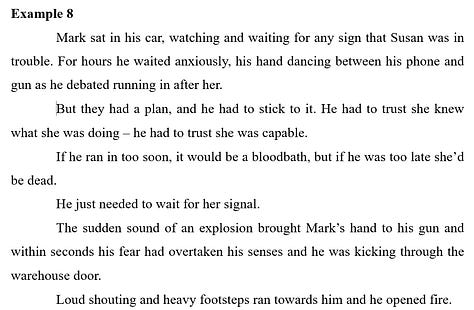Something to consider when writing and editing your book is how best to communicate the story. Often this conversation comes in the form of which narrative style (first person, third person, omniscient, etc) or tense (past, present, future) to use, but there are other areas of storytelling that are worth considering as they, too, impact the readability, engagement, clarity, and pacing in your story.
So, here I’ve decided to dive into a few of these areas. Each one has a few examples to demonstrate what I’m talking about. Please excuse the cheesy writing and cliches, these passages were written quickly to illustrate ideas (and may be changed in a future review of this post).
Dialogue
Dialogue in fiction is most commonly written by starting a new line for each speaker. This helps readers understand where they are and who is speaking without the need for lots of dialogue tags or repetition. The 3 examples below demonstrate why this is important.



Thoughts
Related to dialogue and clarity are thoughts or inner monologues. The most common way to differentiate them from dialogue and prose is to use italics. The examples below demonstrate the difference this makes.



Paragraph lengths
There’s no one size fits all answer for how long a paragraph should be, but the more you read and familiarise yourself with novels, the more intuitive paragraphs will become. Variation of paragraph length can help engage readers and give us a strong sense of rhythm and pacing. The examples below demonstrate how paragraph length can impact the reading experience.
(Note: the choice of how long a paragraph should be is partly stylistic, but readers of certain genres will have a feel for long/short paragraphs.)



Sentence length
Just as with paragraphs, varying the length of sentences can help engage readers and give clear, intentional pacing. As with paragraph length, sentence length is a stylistic choice. The below examples demonstrate the impact short and long sentences can have on a reader.



Punctuation variation
Do you remember in school when you were told you wouldn’t get an A if you didn’t use a semi-colon? Readers may not be grading your work, but using a variety of punctuation can help you better communicate your story, engage readers with your narrative, and control pacing and subtext. The examples below demonstrate how punctuation can impact a reader.


One final point I’d like to mention is the grammar. Grammar is the glue that binds the story and allows you, the writer, to effectively communicate your story with your readers. A good understanding of grammar will help you immeasurably as you progress through your writing journey. For more on this, check out another of my articles, Grammar Shouldn’t Wait For Editors.
If you found this useful, please consider subscribing. I offer discounts on any of my editorial services to all free and paid members.
And if you are looking for an editor, feel free to browse my other articles, website, and get in touch to see if we’re a good fit!



